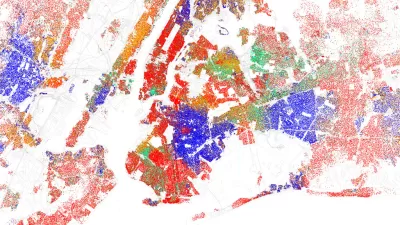Commentators relentlessly debate whether Donald Trump's support hinges on economics or race. Alexis C. Madrigal discusses how the two are joined at the hip, especially in real estate.

Making no attempt to hide his dislike for the candidate, Alexis C. Madrigal points out the folly of separating race and economics as factors in Donald Trump's rise. Looking at the history of segregated American real estate, Madrigal asserts that "for white people in America, 'economic anxiety' has always had a racial component.
"As early 20th century American real estate appraisers 'professionalized' their methods, they built a discriminatory system that literally ranked homes in white northern European neighborhoods as more valuable than homes in neighborhoods where black people (or Mexicans) lived." This provided the germ for "white flight" and troubled "inner cities" in the late 20th century.
Frederick Babcock's 1932 book The Valuation of Real Estate makes a prescient and racist case. As cities develop, "the central districts of a city were built first and were highly valuable, but then prices would fall as the upper classes moved to new housing further and further from the downtown core. At the same time, the closer-in neighborhoods would be successively 'infiltrated' by lower and lower classes."
The way to deal with this, Babcock argued, was to accept it and segregate the classes, by which he also meant races. This theoretical framework informed business and policy choices of later decades, essentially writing itself onto America's urban fabric.
Madrigal denounces how easy it is for otherwise "kindly" white people to accept a system that assigns lower value to non-white households. "So if a black family bought a house on a white family's block, they were effectively costing the white family money."
FULL STORY: Donald Trump and the truth about race and real estate in America

Montreal Mall to Become 6,000 Housing Units
Place Versailles will be transformed into a mixed-use complex over the next 25 years.

Planetizen Federal Action Tracker
A weekly monitor of how Trump’s orders and actions are impacting planners and planning in America.

DARTSpace Platform Streamlines Dallas TOD Application Process
The Dallas transit agency hopes a shorter permitting timeline will boost transit-oriented development around rail stations.

Downtown Cleveland Gets First Ever Protected Bike Lanes
The $200,000 “quick build” lanes are the first of 50 planned miles over five years.

Bend, Deschutes County Move to Restrict Major Homeless Encampment
City and county officials are closing off portions of an area known as Juniper Ridge where many unhoused residents find shelter, hoping to direct people to housing and supportive services.

High Housing Costs Driving Down Transit Ridership in LA
When neighborhoods gentrify and displace lower-income residents, transit ridership suffers, new research shows.
Urban Design for Planners 1: Software Tools
This six-course series explores essential urban design concepts using open source software and equips planners with the tools they need to participate fully in the urban design process.
Planning for Universal Design
Learn the tools for implementing Universal Design in planning regulations.
City of Mt Shasta
City of Camden Redevelopment Agency
City of Astoria
Transportation Research & Education Center (TREC) at Portland State University
City of Camden Redevelopment Agency
Municipality of Princeton (NJ)
Regional Transportation Commission of Southern Nevada





























